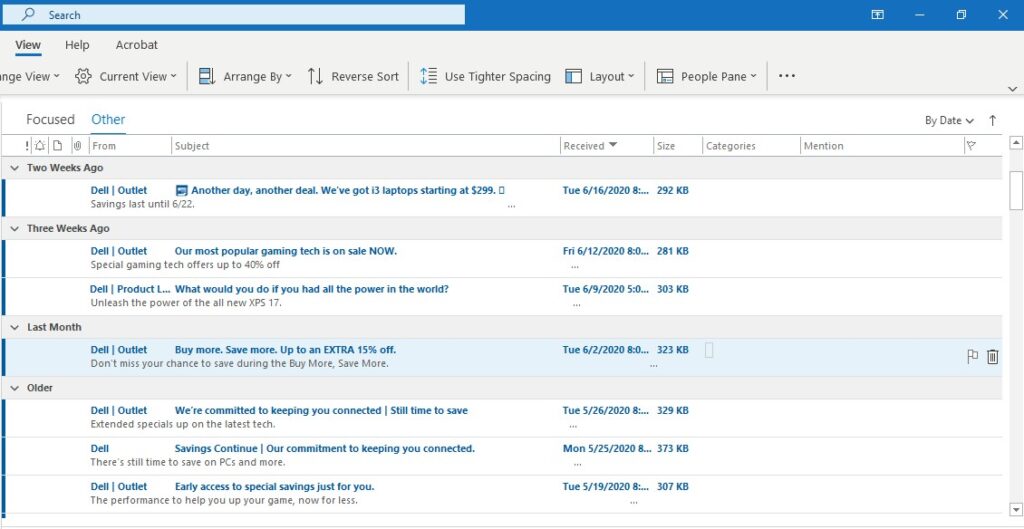
This post was updated on 07/04/2020.
7 Common Email Newsletter Mistakes That Will Make Your Subscribers Very, Very, Very Sad
You know that content is the way to earn and maintain the attention of your audience so you put a lot of effort into creating a fantastic blog. And you’ve got an eNewsletter to remind people of that content.
You’ve got plenty of subscribers but your open rate is painfully low. What gives?
You may be committing some of the most common email newsletter mistakes and not even know it. Fortunately, this list of mistakes are fairly easy to fix and could get that open rate pointing in the right direction pretty quickly.
1. You’re Not Taking Full Advantage Of The Subject Line
The content of an email subject line is the second factor only behind a known sender in determining whether or not someone will open a given email. The only purpose of the subject line should be to get the recipient to open the email.
Unfortunately, too often I see subject lines like these:
- July Newsletter
- Issue 133
- Newsletter Name: July 29, 2015
- Weekly Update
Using dates in the subject line is redundant and completely unnecessary because the recipient’s own inbox tells them when they received the email. Using your subject line to announce that the email is a newsletter is redundant. Your subscribers already know that it’s a newsletter; they knew that when they signed up for it.
Also, if you use the from field to brand your newsletter, there should be no reason to use the subject line for branding purposes.
Use the subject line to entice the subscriber to open the email by teasing the contents of the email itself. Put yourself in the head of your subscribers and think what they would find the most interesting thing in your newsletter and lead with that.
2. You Are Are Not Making Use Of The Preview Text
Most email marketing service providers like MailChimp or Constant Contact provide a space in their templates at the very top of the email for you to add teaser text. This space is usually populated with standard language such as “Having trouble viewing this email? Click here to view this message in a browser.”
The preview text follows the subject line in a subscriber’s inbox. You have more opportunities to entice the subscriber to open your newsletter by using this feature strategically.
A 2005 survey by EmailLabs revealed that 90% of business-to-business e-mail newsletter subscribers have the preview pane function available to them and that 70% frequently or always use it. Further:
- Half of these respondents read just the first few lines in the preview pane to determine whether they should read the rest of the email;
- A third read all of the contents of the preview pane even if they have to scroll or expand the preview pane to do so;
- 15% will read as much as the preview pane allows but won’t scroll to read the rest, if necessary; and
- 45% rarely or never allow images to be downloaded into the preview pane portion of their email messages. Lastly,
- Only 31% of B2B e-mail newsletter subscribers add those addresses to their “safe senders” list.
All of these statistics point to the importance of creating compelling content specifically for recipients to read in the preview pane of their email clients.
If you do not use the preview text function, the subscriber’s inbox will display the first line of text it encounters, which is usually that message inviting people to view the email in a browser.

You’ve forgone another opportunity to boost your open rate if you leave this boilerplate text in place. Use this extra space to persuade your subscriber to open the email. Here’s an example of how Dell Computer uses that space.
If you have amazing content but are not telling your subscribers about it, they would surely be very, very, very sad had they known they missed it.
3. Like Us! Like Us! Like Us!
Back when social media was the new kid on the block, email went through a bit of an identity crisis and started proclaiming (a little too loudly and embarrassingly), “I’m social, too!”
The end result was that follow icons for Facebook, Twitter, LinkedIn, et. al., got stuffed into email templates where they don’t really belong. These icons are simply a distraction because most subscribers will ignore them.
The purpose of an email newsletter is not to build your social following, it’s to be an email newsletter.
If you want to use email to build your following on social channels, create a separate email campaign for that purpose. Or include a blurb within your newsletter that explains the benefits to them for following you.
Treat your subscribers with respect by not begging them to follow you at the top or on the sidebar of your newsletter. Tuck those social icons at the bottom of the newsletter where subscribers can decide for themselves whether or not they want to follow.
I mean, don’t you think that desperately pleading with your subscribers to follow you would surely make them very, very, very sad…for you?
4. The Blah Blah Blah Blah Blah Introductory Paragraph

The introductory paragraph to newsletters are almost always ignored.
According to the Nielsen Norman Group, although the introductory text of the newsletters they studied were on average only three line long, their eyetracking recordings revealed that 67% of users had zero fixations within newsletter introductions.
In other words: Newsletter intros are a waste of space. Get to the point!
Besides, if you’ve teased your content sufficiently in the subject line and preview text, there really shouldn’t be a need for an introductory paragraph.
5. Join Our Mailing List!…Wait, What?
I thought I already had!
What exactly is the point of asking your existing subscribers to join your mailing list? They’ve already done so.
Asking your subscribers who have been receiving your newsletter for months, perhaps years, to join your mailing list when they clearly are already on it will no doubt make them very, very, very sad.
6. First Lets Talk About ME
It is natural. The most interesting topic for most people most of the time is themselves. Organizations are no different in their primal urge to tell people what they want you to know about them.
Resist.
That.
Primal.
Urge.
Don’t stuff all your organizational news at the top of the newsletter. Think about your subscribers and what content they find valuable, compelling, or entertaining and lead with that.
If you must talk about company news that your subscribers probably don’t care about, do it concisely and further down in your newsletter after you’ve given your readers real value.
7. Forget About Forwarding
Every email marketing service offers a “Forward To A Friend” module you can drop into your template that encourages subscribers to do just that with a call to action button.

These modules are worse than useless and here’s why: They take the subscriber to an online form where they can fill out the names and email addresses of their friends.
Think about it. You’re asking your subscribers to spam their friends.
Your subscribers have no guarantees that once they enter their friends’ email addresses in your database, you won’t start spamming them own your own.
Additionally, this process requires many more steps and is far less effective than the way people normally forward emails to friends, using the Forward function of their own inbox.
Prompting your subscribers to share your newsletter is a legitimate list building tactic but the Forward To A Friend module is not an effective way to do it.
Instead, write a unique blurb that asks your subscribers to share. Frame your message in terms of helping to build the community.
If your content is valuable enough, people will naturally want to share it anyway so pay attention to subscribers who have an inordinate number of opens for a given newsletter and figure out some way to lavish them with special attention.
If you fix these seven simple email newsletter mistakes, you’ll be well on your way to both improving your open rate and making your subscribers much happier.
More Email Marketing Goodness
- How NOT To Deal With Unsubscribers
- How To Retain Unsubscribing Cusomters
- Email Sender Scores
- Subject Line Abuse
- The Email Dead Zone
- Up & At ‘Em: Early-Morning Dayparting
- Email Marketing Statistics
3 More Usability Tips For Better Newsletters
The e-Strategy Academy covers all aspects of digital marketing including search optimization & marketing, email marketing, social media marketing, video marketing, mobile marketing & public relations.
